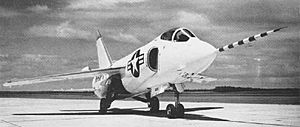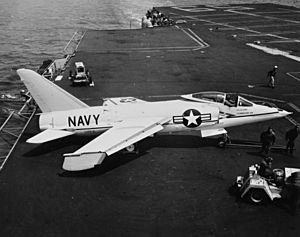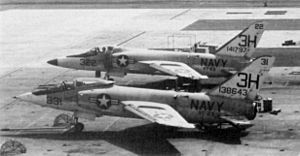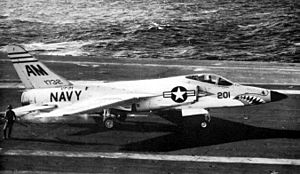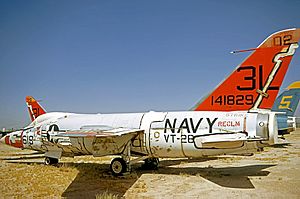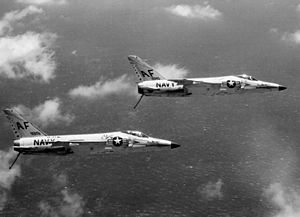Grumman F-11 Tiger facts for kids
class="infobox " style="float: right; clear: right; width: 315px; border-spacing: 2px; text-align: left; font-size: 90%;" ! colspan="2" style="text-align: center; font-size: large; padding-bottom: 0.3em;" | F11F/F-11 Tiger |-
|- | colspan="2" style="text-align: center;" | 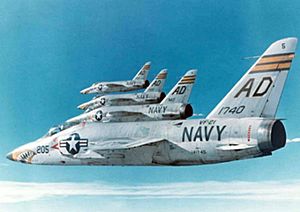 |- |colspan="2" style="border-bottom: 1px solid #aaa;text-align:center;" |VF-21 F11F-1 Tigers in left echelon formation |-
|- |colspan="2" style="border-bottom: 1px solid #aaa;text-align:center;" |VF-21 F11F-1 Tigers in left echelon formation |-
! Role | Fighter aircraft |-
! Manufacturer | Grumman |-
! First flight | 30 July 1954 |-
! Introduction | 1956 |- ! Retired | 1961 (Carrier)
1967 (Training)
1969 (Blue Angels) |-
! Primary user | United States Navy |- ! Produced | 1954–1959 |- ! Number built | 199 |-
! Variants | Grumman F11F-1F Super Tiger |-
|}
The Grumman F11F/F-11 Tiger was a fast, single-seat fighter jet. It was built by the American company Grumman for the United States Navy. This plane was special because it could fly faster than the speed of sound. It was also the first supersonic fighter jet made by Grumman.
For a short time, the Tiger held a world record for flying very high. It reached an amazing altitude of 76,939 feet! The first prototype flew on July 30, 1954. It almost broke the sound barrier on its very first flight. The second prototype was the second U.S. Navy plane ever to fly faster than sound.
In 1956, something very unusual happened. The Tiger became the first jet aircraft to accidentally shoot itself down! The plane was first called the F11F Tiger. Later, its name was changed to F-11 Tiger. The U.S. Navy used 199 of these planes.
Contents
Building the Tiger: Design and Development
Starting the Project
The idea for the F11F Tiger began in 1952. Grumman wanted to make a better version of their F9F-6/7 Cougar jet. This new project was called G-98. The designers wanted to make the new plane as small as possible.
By 1953, the design was completely new. It looked very different from the Cougar. The new plane had special wings. These wings had slats on the front edge and flaps on the back edge. These parts helped the plane control its flight. The wings could also be folded down for storage on aircraft carriers.
The plane was designed to be very fast. It had an all-moving tail that helped it fly at supersonic speeds. The Tiger was powered by a Wright J65 turbojet engine. This engine was a version of the British Armstrong Siddeley Sapphire engine.
First Flights and Tests
The U.S. Navy was very interested in this new design. In 1953, they ordered two prototype planes. These first planes were called XF9F-8, but then changed to XF9F-9.
The first prototype flew on July 30, 1954. It used an engine without an afterburner. Even so, it almost reached the speed of sound! The second prototype had a more powerful engine with an afterburner. It became the second U.S. Navy plane to fly faster than sound. The first was the Douglas F4D Skyray.
In April 1955, the plane got its official name: F11F-1. Later, in 1962, it was renamed F-11A. The Tiger started its carrier tests on April 4, 1956. An F11F-1 Tiger successfully landed on and took off from the USS Forrestal.
The Self-Shooting Incident
On September 21, 1956, the Tiger made history in a strange way. It became the first jet aircraft to shoot itself down! Pilot Tom Attridge was testing its 20 mm cannons. He fired two bursts while diving. As the bullets flew, they slowed down and dropped. The plane kept diving, and its path crossed the path of its own bullets. The bullets hit the plane, causing it to crash-land. Luckily, Tom Attridge survived, though he was injured.
Grumman also thought about making other versions of the Tiger. These included planes for taking pictures from the air and trainer versions. They even proposed a faster version called the Grumman F11F-1F Super Tiger. This version would have used a more powerful General Electric J79 engine.
The Tiger in Action: Operational History
Seven U.S. Navy squadrons flew the F11F Tiger. These included VF-21, VF-33, VF-51, and others. The Tiger flew from several aircraft carriers. These included the Intrepid, Lexington, and Forrestal.
The Tiger did not stay a frontline fighter for very long. It was only used for about four years. This was mainly because another plane, the Vought F-8 Crusader, was faster and better. The Tiger also had problems with its engine and could not fly for very long distances. It was never able to fly supersonic for a long time during normal operations. Because of these issues, the Navy only built 199 F11F-1 (F-11A) fighters.
By 1961, the Tiger was no longer used on aircraft carriers. However, it continued to be used for training. The Naval Air Training Command used them in South Texas. Students would fly the Tiger to get a brief experience of supersonic flight. This helped them prepare for faster fighter jets. The Tiger was good for training because it was easy to fly.
One of the most famous roles for the Tiger was with the Blue Angels. This famous flight team flew the F11F Tiger from 1957 to 1968. The Blue Angels later replaced the Tiger with the McDonnell Douglas F-4 Phantom II. The last Tigers were officially retired from the U.S. Navy in 1969.
A few Tigers were used for special tests even after 1969. In 1973, two former Blue Angels F-11As were used to test new flight control systems. These planes were the very last Tigers to fly, with tests ending in 1975.
Different Versions of the Tiger
Here are some of the different versions of the F11F Tiger:
- YF9F-9: This was the first name given to the prototypes.
- F11F-1: This was the main single-seat fighter version. It was later renamed F-11A in 1962. Grumman built 199 of these. Some later planes had a longer nose.
- F11F-1P: This was a planned version for taking photos from the air, but it was never built.
- F11F-1F Super Tiger (G-98J): This was a special version of the F11F-1 with a more powerful J79-GE-3A engine. Only two of these were built.
- F11F-1T: This was a proposed two-seat trainer version, but it was also never built.
Who Flew the Tiger?
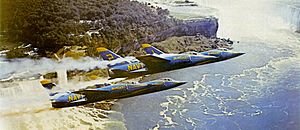
The F11F Tiger was flown by the United States Navy.
- United States Navy
- VF-21, Atlantic Fleet
- VF-24, Pacific Fleet
- VF-33, Atlantic Fleet
- VF-51, Pacific Fleet
- VF-121, Pacific Fleet
- VA-156, Pacific Fleet
- VF-191, Pacific Fleet
- ATU-203 (later VT-23)
- ATU-223 (later VT-26)
- Blue Angels (1957–1969)
Tiger Planes You Can See Today

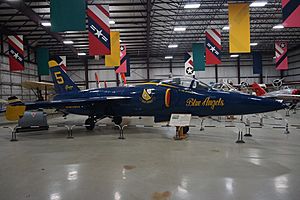
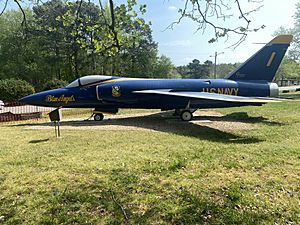
Many F11F-1 Tiger planes are now on display in museums and parks across the United States. Here are some of them:
- 138619 – Stricklands Surplus in Wilmington, North Carolina.
- 138645 – NAF El Centro in Imperial County, California.
- 141735 – Yanks Air Museum in Chino, California.
- 141783 – MAPS Air Museum in Canton, Ohio.
- 141790 – Grissom Air Museum at Grissom Air Reserve Base near Peru, Indiana.
- 141802 – Lawson Creek Park in New Bern, North Carolina.
- 141811 – Combat Air Museum in Topeka, Kansas.
- 141824 – Pima Air & Space Museum in Tucson, Arizona.
- 141828 – National Museum of Naval Aviation at Naval Air Station Pensacola, Florida.
- 141832 – Cradle of Aviation Museum in Garden City, New York.
- 141851 – NAES Lakehurst, New Jersey.
- 141853 – Pueblo Weisbrod Aircraft Museum in Pueblo, Colorado.
- 141859 – Veteran's Memorial Park in Tishomingo, Oklahoma.
- 141864 – NAS Oceana Aviation Historical Park, Virginia.
- 141868 – Planes of Fame Air Museum in Valle, Arizona.
- 141872 – Air Zoo in Kalamazoo, Michigan.
- 141882 – Valiant Air Command Warbird Museum in Titusville, Florida.
- 141869 – Discovery Park of America in Union City, Tennessee.
Facts and Figures (F11F-1/F-11A)
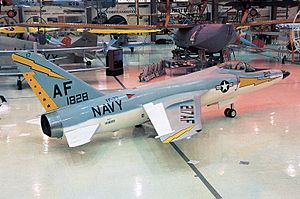
Data from United States Navy Aircraft since 1911 Standard Aircraft Characteristics: F-11A
General characteristics
- Crew: 1
- Length: 45 ft 10.5 in (13.983 m)
- Wingspan: 31 ft 7.5 in (9.639 m)
- Width: 27 ft 4 in (8.33 m) wing-tips folded
- Height: 13 ft 2.75 in (4.0323 m)
- Wing area: 250 sq ft (23 m2)
- Empty weight: 13,810 lb (6,264 kg)
- Gross weight: 21,035 lb (9,541 kg)
- Max takeoff weight: 23,459 lb (10,641 kg)
- Powerplant: 1 × Wright J65-W-18 afterburning turbojet engine, 7,450 lbf (33.1 kN) thrust at 8,300 rpm, military power dry, 10,500 lbf (47 kN) with afterburner
Performance
- Maximum speed: 631 kn (726 mph; 1,169 km/h) / M1.1 at 35,000 ft (10,668 m)
-
-
-
- 654 kn (753 mph; 1,211 km/h) at sea level
-
-
- Cruise speed: 501 kn (577 mph; 928 km/h)
- Range: 1,110 nmi (1,277 mi; 2,056 km)
- Service ceiling: 49,000 ft (15,000 m)
- Rate of climb: 16,300 ft/min (83 m/s)
- Wing loading: 84 lb/sq ft (410 kg/m2)
- Thrust/weight: 0.5
Armament
- Guns: 4 × 20 mm (.79 in) Colt Mk 12 cannon, 125 rounds per gun
- Hardpoints: 4 with a capacity of –,with provisions to carry combinations of:
- Rockets: Aero 6A or Aero 7A "Rocket Package"
- Missiles: AIM-9 Sidewinder
- Other: 150 US gal (570 L) drop tank
Avionics
- AN/ARC-27A UHF COMMS
- AN/ARA-25 UHF
- AN/ARR-40 UHF
- AN/ARN-14E VHF Nav
- AN/APX-6B IFF
- AN/APA-89 video coder
- AN/APG-30A ranging radar
See also
 In Spanish: Grumman F-11 Tiger para niños
In Spanish: Grumman F-11 Tiger para niños
- Aircraft related to this one
- Grumman F-9 Cougar
- Grumman F11F-1F Super Tiger
- Grumman G-118
- Similar aircraft
- Douglas F5D Skylancer
- Supermarine Scimitar
- Vought F-8 Crusader
- Lists related to this aircraft
- List of fighter aircraft
- List of military aircraft of the United States


